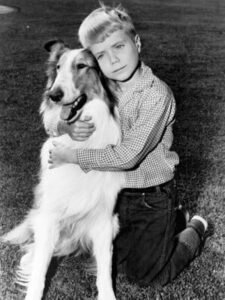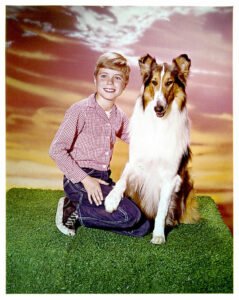For almost twenty years, many of us remember watching the adventures of TV’s most famous dog – Lassie.
This beloved Rough Collie and her human friends were on our screens for 17 seasons, from 1954 to 1973. The show even switched from black and white to color in the 1960s.
But one of the most unforgettable parts of the show was when 7-year-old Timmy Martin joined in the fourth season. Timmy and his family adopted Lassie, creating some of the most memorable moments in the series.

Jon Provost, who played Timmy on *Lassie*, just celebrated his 74th birthday. He looks back fondly on his time filming with his four-legged co-star and remembers how Hollywood discovered him at only 3 years old.
The actor, born in Los Angeles, recalls that when he was 3, his mom took him to an audition for a Jane Wyman movie. She was a huge fan and just wanted her autograph. But out of 200 kids, Jon got the part.
Acting wasn’t something that ran in the family. Jon’s father had a completely different job—he was an aeronautical engineer.
“My parents weren’t Hollywood people,” Jon said. “My father is from Alabama, and my mother is from Texas.”

At age 4, Jon Provost landed a role in a movie with Grace Kelly and Bing Crosby.
“I didn’t have an agent at the time. After that, I got one, and it led to more movies like *The Country Girl* with Bing Crosby and Grace Kelly. I did about 12 movies before I started *Lassie*,” he told Fox News.
Jon also shared memories of working with the three different male dogs who played the role of Lassie. He said he formed a special bond with the last dog who portrayed the famous female collie.

“I did the show for seven years, filming 249 half-hour episodes. I worked with three different Lassies,” Jon Provost told Fox News.
He shared that the last dog he worked with was by his side for five years straight. “We grew up together. For five years, we saw each other five days a week, and sometimes even on weekends.”
Jon also revealed how well-behaved the dog was on set. “The actors made more mistakes than the dog,” he laughed. “They were more of a problem than Lassie.”

After leaving *Lassie* at 14 years old, Jon Provost went on to star with big names like Natalie Wood and Kurt Russell. Despite growing up in Hollywood, he avoided the common pitfalls many child actors face.
“My parents let me pretty much do what I wanted to do. I didn’t have to take a job,” Jon said.
Looking back, he added, “When I left Hollywood, I thought it was good that I did.”

Today, Jon lives away from the spotlight in Northern California but still receives fan mail from his time on *Lassie*. In 1994, he was honored with a star on the Hollywood Walk of Fame.
The character Lassie became so famous that she even had her own radio series.
In 1979, Jon married Sandy Goosens, and they had two children, Ryan and Katie. However, after 14 years of marriage, they divorced in December 1993.
In 1999, Jon found love again when he married Laurie Jacobson, a well-known researcher and author.
I’ve always been a big fan of the adventures this sweet duo went on. And with a moral in every episode, it was the perfect show for kids.
Please share this with all the *Lassie* fans you know.
My Brother Covertly Took the $20K My Grandmother Left for Me Before Her Death — Karma Intervened Before I Could Confront Him

The moment I saw my brother cruising around in a shiny red convertible, I knew something was off. Little did I know, that car held the key to a betrayal I never saw coming — and a plan Gran had set in motion long before she was gone.
My name is Juniper. I’m 26 now, and I’ve been living out of state for four years. Honestly, it was the best decision I ever made: to get away from my family and from all the hurt that came with it.
It wasn’t like I ever felt a part of them. My parents had always favored my older brother, Maverick. You could say he was the golden child, but that doesn’t even cover it. Growing up, I was just… there. The “spare,” as Gran used to joke, though there was always a tenderness in her voice when she said it.
That’s part of why I left. Well, that, and Noel — my boyfriend. He convinced me it was time to live for myself, to create something outside the shadows of my family.
We packed up our little car, and I moved with him to the city, away from my parents, Maverick, and all the memories.
“Noel, I swear, I just couldn’t stay there anymore,” I had told him over dinner once. I still remember the way he’d smiled at me from across the table, his hand reaching out to grab mine.
“You don’t need to explain it to me again, June. You did the right thing,” he had reassured me, squeezing my hand. “You deserve more than being the second choice.”
Even after four years away, I barely spoke to my family. Calls came less frequently, texts became a rare formality. My parents? They didn’t seem to mind, honestly. It was like I had just faded out of their lives. The only one who stayed in touch was Gran.
She was the one person in my family who made me feel like I mattered. When I was younger, she’d sneak me chocolate bars when my mom wasn’t looking, or call me on the phone late at night just to hear how my day went.
Gran didn’t care if it was boring or if I felt like my life was a mess. She just listened.
And then, one day, I found out she died. Accidentally. No call, no message, nothing. Can you believe that? I was scrolling through Facebook, of all places, and saw a post from an old family friend. Gran’s picture. A date and a “Rest in Peace” note.
I couldn’t breathe. I stared at my phone, waiting for things to make sense, but they didn’t. My heart felt like it had been ripped out of my chest.
I dropped my phone on the table, stood up, and muttered, “Gran’s gone.”
Noel looked up from the couch. “What? What do you mean she’s gone?”
“She died. No one even told me.” I could feel the burn of tears, but it was more than sadness; it was anger and perhaps betrayal. “How could they not tell me?”
Noel was up in a second, pulling me into a hug, but it didn’t make any sense. Why hadn’t my parents called me? Even Maverick. Nothing.
I booked a flight back home that same night.
I didn’t care what it took — I had to visit Gran’s grave. I had to say goodbye, at least on my own terms. The next morning, I found myself walking through my hometown, the place I hadn’t seen in years, the place I had fought so hard to escape. Everything was as I remembered, except one thing.
I blinked, stunned. “The… what?”
As I stood at the corner of the street near the cemetery, I spotted something that made my blood run cold. My brother, Maverick, cruising by in a shiny red convertible.
Maverick? The one who still worked as a cashier, who could barely make ends meet? He was driving a red convertible that looked like it cost more than his entire life savings.
My stomach churned. Something wasn’t right.
Later that day, I found myself standing by Gran’s grave, the soft rustle of the trees the only sound around. The earth was still fresh, and I couldn’t shake the knot in my stomach. Gran was really gone. I hadn’t been able to say goodbye properly: no chance to tell her how much she meant to me.
The pain of finding out about her death through a Facebook post still stung like an open wound.
As I knelt beside the grave, I heard footsteps approaching. I looked up to see Mr. Anderson, Gran’s best friend. He was a kind, older man, always hovering around Gran, helping her with anything she needed. His face was somber as he approached.
“Juniper, I’m so sorry,” he said softly, standing beside me. “Your Gran… she was a one-of-a-kind lady.”
I swallowed the lump in my throat. “She really was. I just wish I had more time with her.”
He nodded, his eyes distant. Then, after a moment of silence, he turned to me and asked, “Did you get the $20,000 she left you?”
I blinked, stunned. “The… what?”
Mr. Anderson’s brow furrowed. “Your Gran. She mentioned in her will that she set aside $20,000 for you. I just assumed you knew.”
My heart dropped. Suddenly, the red convertible Maverick was driving made all the sense in the world. The anger that had been simmering inside me boiled over. “No,” I muttered, standing up, fists clenched at my sides. “I didn’t know.”
Mr. Anderson’s face paled. “Oh, Juniper, I’m so sorry.”
But I wasn’t listening anymore. I had to get to Maverick’s trailer. Now.
I stormed back to my car, my mind racing. Maverick, who could never hold down a steady job, was suddenly driving around in a flashy car, and I hadn’t thought twice about it? Of course, it was my money. The money Gran left me — the one person in my family who actually cared about me — and he stole it without a second thought.
When I pulled up to Maverick’s trailer, I was ready for a full-blown confrontation. But what I saw stopped me in my tracks. There, crumpled in the driveway, was the red convertible, completely wrecked. The front bumper was smashed, the windshield shattered, and the tires looked flat, like the car had been in a serious accident.
And there, standing in the doorway of his beat-up trailer, was Maverick. He was leaning on crutches, a cast covering his leg, and his face was bruised, a mess of cuts and scrapes.
Karma had already caught up with him.
I walked up to him, my anger momentarily replaced by shock. “Maverick, what the hell happened?”
He shifted uncomfortably on his crutches, his eyes darting away from mine. “It’s… it’s nothing.”
“Nothing?” I gestured at the totaled car. “That doesn’t look like nothing. What did you do? And why did you take Gran’s money, Maverick?”
He winced, knowing he couldn’t avoid it any longer. “I didn’t mean for it to go like this, Juniper. I… I just thought I’d borrow it. I was gonna pay you back. But then I saw that car, and…”
“Borrow it?” I was incredulous. “You don’t just ‘borrow’ twenty thousand dollars that wasn’t left to you. Gran left that money for me, and you took it like it was nothing. And now look at you. This is karma, Maverick. This is what you deserve.”
Maverick opened his mouth to protest, but I wasn’t finished. “You’ve always taken everything. My parents’ attention, their affection: everything was always about you. But this? This was different. This was from Gran, the one person who actually gave a damn about me, and you stole it.”
Maverick hung his head. “I messed up, okay? I thought—”
“You thought what?” I snapped. “That I wouldn’t find out? That I didn’t deserve what Gran left me?”
He didn’t have an answer. We stood there in silence, the weight of everything hanging in the air. Then, just as I was about to turn and leave, my phone buzzed in my pocket. It was Mr. Clearwater, Gran’s lawyer.
“Mr. Clearwater?” I answered, keeping my eyes on Maverick.
“Juniper, I’ve been going over your grandmother’s will,” Mr. Clearwater said. His voice was calm and steady, as though he knew I needed some reassurance. “There’s something you should know. Your grandmother predicted this might happen.”
“What do you mean?” I asked, my heart pounding in my chest.
“She knew Maverick might try to take the money, so she had a plan in place. The $20,000 was only a part of her estate. The rest of it — her house, her savings, her investments — it’s all yours, Juniper. She left everything to you.”
I couldn’t believe what I was hearing. “Everything?”
“Yes, everything,” Mr. Clearwater confirmed. “Your grandmother was very clear. She wanted to ensure you were taken care of, so you wouldn’t have to rely on anyone.”
Tears pricked at my eyes, but they weren’t just from sadness. Gran had known. She saw this coming, every bit of it, and she had protected me in the way only she could. Even in death, she was still looking out for me: still showing me that I mattered.
I took a deep breath, steadying myself as I looked at Maverick. “I hope that convertible was worth it, Maverick. I hope you enjoyed the ride.”
“Juniper, I—” he started, his voice shaky.
I held up my hand, cutting him off. “Don’t. I’m done with excuses, Maverick. Just save it.”
Without waiting for a response, I turned and walked away, leaving him standing there, broken in more ways than one. For the first time in my life, I didn’t feel like the forgotten sibling. Gran had made sure of that.
If this story touched your heart, take a look at another exciting read: When my grandmother asked us to come to her place to celebrate her birthday, I didn’t expect my family to do what they did! Grandma was hurt by their actions, and I wasn’t willing to let my family go unpunished. So I came up with a plan that put them in their place!



Leave a Reply